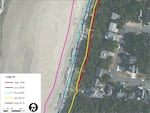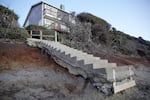
Ten property owners in the Pine Beach development near Rockaway Beach have been allowed to build a buried rip rap barrier against ocean erosion. It's been covered with sand and planted with vegetation.
Kristian Foden-Vencil / OPB
Editor’s note: This is the second story in a series looking at the impact of erosion on the Oregon coast, and the hard decisions facing property owners and land use regulators. The first story looked at the future of Highway 101.
Back in 2016 Michael Ellis, a former president of the Fred Meyer grocery chain, bought a lot in the Pine Beach development along Tillamook County’s Rockaway Beach.
He built a house, but never really considered it oceanfront property. That’s because a stretch of dunes lay between his home and the beach. The dunes were common ground, accessible to everyone.
“It was all trees, some spruce trees, some shore pines. It was like you’re in a mountain cabin, versus a beach cabin,” Ellis said. “But you still had the ability to walk down a little pathway and go down to the beach.”
Over the last few years, however, the ocean has eroded just about all that common ground. So Ellis and his neighbors banded together to find a way to protect their properties.
Their options included trucking in more sand, planting more trees or moving their homes upward or inland. But none of those seemed as viable as using of rip rap – piles of boulders that break up wave energy and prevent erosion.

Michael Ellis bought a lot near the ocean in 2016, but never considered it to be oceanfront property because there was a wide swath of public dunes between him and the beach. Now those dunes have been largely washed away.
Kristian Foden-Vencil / OPB
“If we do nothing, the ocean front homes would be gone,” Ellis said. “And then the next set of homes behind those would be the next to go.”
This fall, Tillamook County commissioners allowed 10 homeowners in the Pine Beach development to use rip rap. Over the last few months, each has spent $100,000 or more to build a barrier. It’s one long pile of rocks, each the size of about a third of a car, buried deep in their backyards and topped with sand and vegetation.
Without this reinforcement, Ellis said, the Pacific Ocean would destroy his house and much of the neighborhood – leaving behind a mess of ruined homes.

Documents submitted to Tillamook County for the Pine Beach Goal 18 exception permit show how the dunes have eroded since 1994.
WEST Consultants, Inc
To county commissioners who approved the plan, these erosion prevention efforts sound logical. But there’s a problem: Oregon land-use rules largely ban shoreline armoring, under what’s known as Goal 18. The policy, adopted back in 1977, banned the use of rip rap to protect new development, unless the site qualified for an exception.
State regulators back then hoped Goal 18 would keep the Oregon Coast from coming to resemble California’s coastline, where in certain spots you can find mile after mile of rip-rapped beaches.
“People were starting to build out on the beach and there was a feeling that that wasn’t something that they wanted,” said Meg Reed, a coastal specialist with the Oregon Department of Land Conservation and Development.
At the time Goal 18 was adopted, scientists were also realizing that rip rap changes the wave action on a beach, scouring away sand and potentially leaving no beach for the public to enjoy.
So there’s a natural friction between the hundreds of thousands of Oregonians who live on the coast and want their properties protected from the ocean, and environmentalists and visitors, who vacation here and want to protect the beautiful vistas.
These kinds of neighborhood spats go on all the time, and all over Oregon and Washington, whether they’re about new fences or parking rights or rip rap. What makes this disagreement so important is that, after decades of largely sticking to Goal 18 rip-rap rules, Tillamook County has decided to toss them out, said Phillip Johnson, executive director of the Oregon Shores Conservation Coalition
“It’s not new that we’re getting more and more attempts to rip rap the shoreline due to increased erosion,” he said. “But this is like an order of magnitude more, where they’re just trying to suspend Goal 18. And that’s what makes this particular case so important.”

Many homes along the Oregon coast are threatened by ocean erosion. Goal 18 bans shoreline armoring such as rip rap unless the home was developed before 1977.
Kristian Foden-Vencil / OPB
Johnson said it’s clear Pine Beach wasn’t around back in 1977, so it should not be allowed to be rip-rapped. He’s also upset that homeowners went straight for an industrial-scale erosion measure such as rip rap, instead of trying other less intense solutions, like adding sand or vegetation.
The Oregon Shores Conservation Coalition is fighting Tillamook County’s decision and taking the Pine Beach case to Oregon’s Land Use Board of Appeals, or LUBA. They’re joined in their case by the Surfrider Foundation and the Oregon Department of Land Conservation and Development.
LUBA was established by the state Legislature in 1979, and its members rule on appeals of land use decisions made by local governments.
Tillamook County commissioners told OPB they can’t comment on the case because it is headed for appeal.
But Wendie Kellington, the lawyer for the homeowners, is happy to talk. She points out that Goal 18 has a clause that allows certain government agencies to grant exceptions to the rip rap rules. And in this case, she said, an exception is justified, because when Tillamook County approved the Pine Beach development in the 1990s, independent surveyors said the ocean had been adding sand to the beach for 70 years. They also said the area was relatively safe from the threat of erosion.
“These (homeowners) did everything right. This is not a situation where you have people who are tempting fate,” Kellington said.
But now, that common ground of trees and sand dunes has been washed away.
The Pine Beach development is also located between two jetties, about five miles apart, built 70 years ago, and Kellington said those have contributed to the erosion.
“The natural processes were forever and irrevocably altered by these two man-made jetty systems that exist nowhere else in the entire state of Oregon,” she said.
Environmentalists disagree with Kellington’s suggestion that the jetties had a major impact on erosion. And they worry about the precedent Tillamook County is setting by allowing rip rap here.
To secure the exception to Goal 18, Kellington had to convince commissioners that the situation was unique and exceptional, so it doesn’t create a precedent. Kellington expects LUBA to side with homeowners. She thinks 90% of owners in the area between the jetties are entitled to rip rap and it’s just a matter of time before this segment of the coast can be rip-rapped without Goal 18 exceptions.
Back at the beach, the effect of Goal 18 is clearly visible. The Shorewood RV Resort was developed before 1977, so it’s protected on three sides by rip rap. As the beach has eroded, the RV resort now juts out onto the beach. The public can’t walk past the site at high tide.
It’s a vivid illustration of how, over time, a mixture of erosion and land-use rules are reshaping of Oregon’s coastline.
In Micheal Ellis’s beach neighborhood, you might expect everyone to support the new rip-rap barrier. After all, it’s their homes at risk. But there is dissent.
“The ocean should be allowed to do what it will do,” said software engineer Dale Wacker, who lives a few doors inland from Ellis. He thinks the new barrier at Pine Beach detracts from the natural beauty of the area, and he’s not even sure the reinforcement will work.
“When we get king tides, it fires massive logs into these properties … into their yards. And so now, there’s a 3-foot wall there that’s intended to stop that,” Wacker said. “Three feet to the ocean is not very significant in my opinion.”

Rockaway Beach resident Dale Wacker, said the rip-rap debate has changed the community he remembers. "No Trespassing" and "No Parking" signs abound. Wacker said he left the city to get away from that kind of mindset.
Kristian Foden-Vencil / OPB
Wacker said the whole debate has changed the community he remembers. He points to new signs saying “No Trespassing” and “No Parking.” Wacker said he left the Portland area to get away from that kind of mindset.
The Pine Beach development is not the only area to recently be given an exception to Goal 18. Homeowners along Gleneden Beach, in Lincoln County, received one on the grounds that more than 80% of homes there were already rip-rapped. Lincoln County leaders decided all that preexisting reinforcement had already irrevocably changed the natural environment, so more wasn’t going to make much difference.

Before and after pictures of a house that's recently been rip-rapped at Gleneden Beach.
Kristian Foden-Vencil / OPB
The Oregon Shores Conservation Coalition opposed the Lincoln County exception, but is not taking it to the Oregon Land Use Board of Appeals.
Meanwhile, the barrier at the Pine Beach development has been built, the lawyers are preparing their cases, and the Oregon Land Use Board of Appeals should have a decision by the fall.
